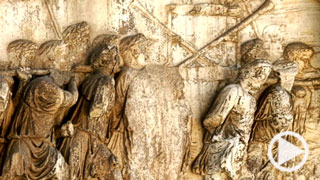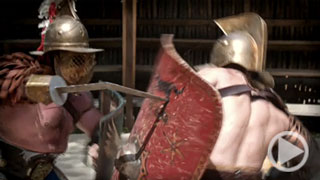- Home
- »
- Italy
- »
- Rome
- »
- The Colosseum
- »
- The Colosseum - The Colosseum - behind the scenes
The Colosseum - Behind The Scenes
The Colosseum – behind the scenes
Early in the morning spectators were already streaming into the arena. The show began with the pompa, a procession of gladiators who entered through the porta triumphalis, the main entrance in the west. Among them were people who had been condemned to death. Tablets with inscriptions told of their crimes.
The staged animal hunts – the venationes – took place during the morning. On one occasion the fighters slaughtered up to 5,000 animals on a single day. Lions, tigers, panthers, leopards, elephants – even rhinoceroses – were among the exotic animals from faraway lands that were killed here to entertain the crowds. But the menagerie also included animals like bulls, bears, boar and stags from northern regions of the Empire. It was a precise map of Roman expansion.
One legacy of the wild beast hunts is the variety of plant species that grow in the arena to this day. Over the centuries, the seeds brought by the animals from around the Empire were able to propagate in the mild Roman climate.
Suddenly a group of leopards appeared out of nowhere. The animal hunters, the venatores, braced themselves for the hungry carnivores. Eye contact was made, and the hunt could begin. The idea was to give the two sides equal chances. Sharp claws and powerful fangs were matched by lance and shield. As a special thrill for the viewers, some of the humans had to fight in the nude.
The venatores were recruited from the ranks of slaves and prisoners. They were not as well-respected as the gladiators, but like them they risked their lives in the arena. But not only were humans pitted against beasts – often the animals were set at each other: elephants against bulls, lions against horses or panthers against goats. The demand for wild animals was immense and bringing them to Rome cost vast sums. The governors of the North African provinces had great difficulty in filling the orders. The most sought-after animals were lions and leopards.
Hunters set traps for the great cats, luring them with gazelles, sheep or goats. Once they ended up in the fenced-in area with the net, the chasers stabbed at them with lances. The only escape route into the wooden crate became their doom – the horse-drawn carts transported them to their certain death.
Once they reached the port, other animals were already being driven on board the ship. Antelopes and ostriches were led on deck from the quay. The wooden crate that these men are carrying may contain leopards. The sailors raised the sail, the boat embarked, setting course for Ostia, the harbor outside the gates of Rome. Before their arrival in the arena, the animals were loaded onto smaller boats, heading upriver. The banks of the Tiber were no great distance from the cages of the amphitheater – the last station before the spectacle. Once the animals were confined, the keepers, the bestiarii, began to provoke them mercilessly. They tortured young animals in front of their mothers. They rubbed salt into fresh wounds. Or they fed the animals human flesh – to accustom them to the taste. The more raging the animals, the bloodier the show would be.

Six meters below the arena Domitian, who became emperor after the death of his brother Titus, built a basement with corridor and supply ducts. Behind the scenes the staff had 15 different corridors at their disposal to prepare the spectacle. Lifts hoisted the animals, people and stagehands into the arena. The stench of the big cats mingled with the sweat of the slaves and the soot from the torches in the terrifying labyrinth.
These metal clamps held the posts that supported the lifts. The slaves pulled the ropes on the wooden winches. Initially there were 28 lifts, and 224 men were needed to send up the animals simultaneously. Later there were reportedly 60 lifts in operation. The excited leopards entered the arena via trap doors. The deadly games could begin. But soon animals were not enough to satisfy the crowd. Once hooked, the spectators demanded new thrills. Roman courts began to pronounce a horrific sentence on agitators, arsonists and criminals – damnatio ad bestias, - death by beasts of prey.
At midday the condemned were thrown to the wild animals as food. Tied to a pole one of the convicts awaits his sentence. A leopard leaps on him and rips the flesh from his bones. To make them more entertaining, such scenes were sometimes built into narratives from mythology. The imagination of the Romans seemed boundless.
Deus ex machina was the term for the sudden appearance of a god in the ancient Greek theater. This special effect was achieved with the help of a simple crane. By contrast, the Roman emperors had entire worlds staged for the populace. The sophisticated stage technology in the basement ensured that the audience would be captivated. And not only animals were hoisted into the arena. Entire stage sets mounted on platforms were lifted for epic scenes.
Such as the well-known legend of Orpheus, who tamed wild beasts with the sound of his lyre. In this reality show of the ancient world, a prisoner was dressed up and sent into the arena to charm the animals with sweet song.
But there he lay, mauled by hideous bears. This thing alone went against the myth. -That was how Martial described the inevitable real-life outcome.
A simpler, but no less popular, scene was the human torch. Assistants poured a flammable liquid onto the prisoner’s clothing and set it alight. The audience enjoyed the light show as night fell on the arena.
After the shows the floor of the arena was drenched with blood. Slaves appeared to pour on fresh sand. They collected the severed limbs and entrails in carts and brought them down to the basement. During the clean-up, vendors went through the rows of seats, hawking snacks to the crowds of ordinary Romans, the plebs. The intermission also gave spectators time to maintain their oral hygiene – the Romans were familiar with toothpicks.
But at this point the tension was growing, because after the midday break it was time for the true heroes of the spectacle. Fans commemorated their idols in stone – leaving this two thousand year old graffiti.





